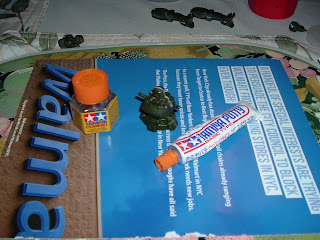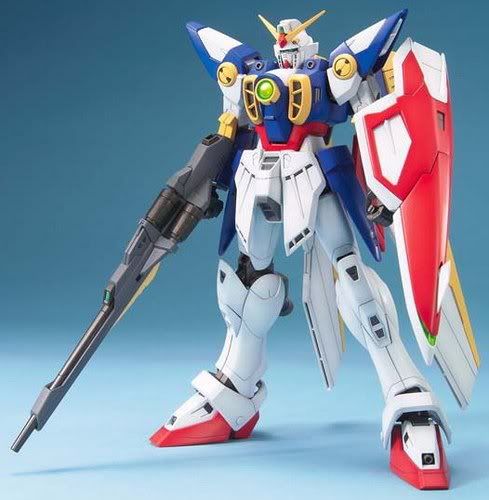Welcome to the show. Today's guest is none other than myself (again), and I'll be talking about the different varieties of Gunpla available for your consumption. And believe me, there are tons of varieties out there. From cups of instant noodles with a "toy surprise" to 5-foot-tall robots minding the fence at shopping malls. You've got Gunpla that can transform and combine with one another, and others that shoot their own heads instead of missiles. And there are even Gundam models that have all the articulation of an action figure in a single finger. So you'd be most mistaken in saying a Gundam kit is a Gundam kit. To save you the torment of an endless online search, this guide will only cover the types of Gunpla you're most likely to find.
Scale
The RX-78-2 Gundam in various scales
A popular question among beginners is how to measure Gunpla by their scale, a ratio that determines the size of the finished product representing the 'real' thing. First, look up your robot's fictional specs, preferably at Gundam Official or MAHQ. They will include your robot's overall height in meters. Then you convert the height to centimeters, multiply it by the model's scale, and convert the estimate to inches if desired. For example the height of the original RX-78-2 Gundam is 18.5 meters, or 1850 centimeters. If you find, say, a 1/144th scale model of the Gundam, then:
1850cm * 1/144 = 12.8cm, or 5 inches
If you know your robot's height--and your math--you can estimate the size of a completed model before you even open the box. Just to make life a little easier, here are the 3 most popular scales for Gunpla:
1/144 - Roughly 5-6 inches tall
1/100 - Roughly 7-8 inches tall
1/60 - About 12 inches tall
Now we'll discuss the different levels of quality of Gunpla. Basically, the more money you spend, the bigger your completed kit will be, and the more color-molded parts, articulation, details and features it'll have. Another factor in determining the quality of Gunpla is age; some of the newest kits have significant improvements over the ones your probably saw at Toys"R"Us years back. Also note that the prices listed here are only estimates. Kits can cost more depending on their availability and where you shop.
Super Deformed (SD)
SD God Gundam
Measuring 3 1/2 inches tall, SD kits are stubby, big-headed caricatures of various Gundam robots. Having large parts molded in 4-5 colors, they include stickers for accuracy. SD kits include the gimmicks of their bigger counterparts, as well as extras like snap-on armor and spring-loaded missile launchers. Once having less than 8 points of articulation, SD's now have swiveling waists and ball-jointed legs for more poses. "Musha Gundams," SD's with samurai armor and gimmicks, are also available. SD's go for 400-1,400 Japanese yen ($5-$18 USD).
First Grade (FG) 1/144
1/144 FG Gundam Exia Rollout Colors
A more affordable way to get your feet wet in Gunpla, the parts are removed from their runners by hand. The first FG's were reissued versions of the first model kits inspired by Mobile Suit Gundam. They have about 9 points of articulation and are well-proportioned but are also molded in one color. The FG's inspired by the Gundam 00 series, however, are molded in 4 colors and have joints made from soft ABS plastic. FG's are priced at 300-500 yen ($3-$6 USD).
"No Grade (NG)" 1/144
1/144 Gundam Double X
Referred to as such by fans for lack of any classification, these kits are molded in 4-5 colors, include stickers and need minimal painting for color accuracy. They bear about 16 points in articulation and their estimated price is 500-700 yen ($6-$10 USD).
High Grade (HG) 1/144
1/144 HG RX-78-2 Gundam
A big step up from FG's and NG's, about 90% of an HG's parts are molded in the right colors, requiring almost no paint for accuracy. They are also slightly more articulated than NG's. HG's have more parts to assemble and cost more, but you wind up with a great model in a convenient size. Though this line features robots from almost every Gundam show, most HG's represent machines from Gundam's "Universal Century (U.C.)" timeline. They're priced at 600-2,000 yen ($8-$25 USD).
Real Grade (RG) 1/144
1/144 RG Aile Strike Gundam
The newest line of Gunpla, these kits are 99% pre-colored, are painstakingly detailed, and include an pre-assembled internal 'skeleton' providing about 40 or so points of articulation. They even come with posable hands with holes to grab weapons. So far, RG versions of the RX-78-2 Gundam, Char Aznable's Red Zaku II and Gundam SEED's Aile Strike Gundam are available, with the mass-produced green Zaku II on the way. They're priced at 1,500-2,000 yen ($19-$30 USD).
No Grade 1/100
1/100 Gundam Deathscythe Hell Custom
Once classified as High Grades, these are simply bigger versions of their 1/144 counterparts, with more parts and more articulation. Not much has changed in this line except that the newest 1/100's include battery-powered lights. They're priced at 1,500-3,000 yen ($18-$40 USD).
Master Grade (MG) 1/100
The line that inspired the Real Grade brand, Master Grades maintain the same color accuracy, detail and the ability to perform a wide array of poses, though only the latest MG's have begun to fully utilize its internal frame technology. Some limited-edition kits have clear armor that shows off the inner frame, while others have working lights. MG's are priced at 2,800-8,000 yen ($40-$100 USD)
Perfect Grade (PG) 1/60
1/60 PG Wing Gundam Zero Custom
The ultimate accumulation of Gunpla technology, the 12-inch-tall Perfect Grades include perfect color molding, an inner frame for near-endless articulation, incredible detail, rub-on/water-slide decals, springs, wires, screws and light-up eyes and chest pieces. Because these kits are heavy-duty and very expensive, I personally don't recommend them to beginning modelers. They cost 9,600-24,000 yen ($120-$300 USD).
EX Model 1/144/U.C. Hard Graph 1/35
1/35 UCHG M61A5 Main Battle Tank
Both of these lines specialize in non-robotic vehicles from the Gundam universe and are marketed toward expert modelers. The EX kits depict mostly air and spacecraft and are molded in one color, include snap-fit parts, and require painting. Better suited for dioramas, Hard Graph kits add a distinct military flavor with conventional tanks and ground vehicles (and even throw in figurines). Though they include snap-fit multicolored parts, some parts need to be glued and a full paint job does wonders. The EX kits sell for 2,250-3,600 yen ($28-$45 USD), while the Hard Graph kits sell for 1,200-7,200 yen ($15-$90 USD).
Resin Kits
1/144 Gerbera Gundam
Resin is described as a hydrocarbon secretion of various plants. Resin kits are made by injecting a liquefied synthetic resin into silicone rubber molds before the liquid itself hardens. Though even amateurs can cast resin kits at little cost, it involves a lot of hands-on labor which easily jacks up the price to thousands of Japanese yen or hundreds of American dollars. Depicting more obscure robots from Gundam, resin kits need to be cleaned, glued and painted. And you have to fix any imperfections yourself. Some resin kits are "conversion parts" used to complement or modify regular plastic models. For experts only.
Show's over. Join us next time when I (finally) get you up to speed on my latest work in progress. Until then, GET OFF MY STAGE!!!
Special thanks to Gunjap.net for providing the last pic for this post.

































